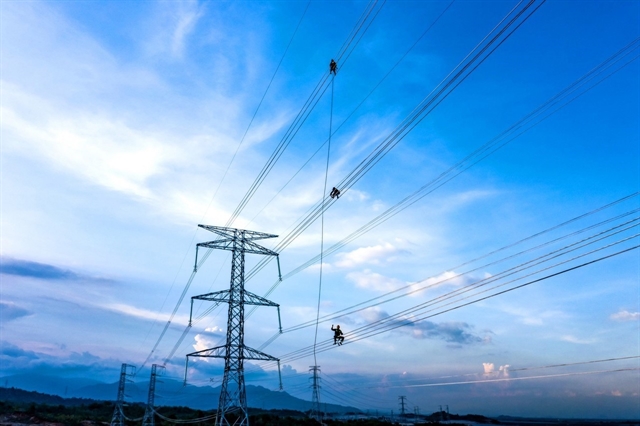 Economy
Economy


|
| Transmission lines are installed to connect renewable energy plants in Thuận Nam District, Bình Thuận Province. — VNA/VNS Photo Công Thử |
HÀ NỘI — As private investment can play a significant role in increasing local power supply, experts have worked to find better mechanisms and policies to solve problems that have discouraged investment in the sector.
Deputy Minister of Industry and Trade Hoàng Quốc Vượng told a seminar on independent power producers (IPPs) in Hà Nội on Friday that electricity demand will increase by 7.5- 8 per cent per year by 2030 when local production capacity nationwide should reach 526 billion kWh, meaning the total capacity of the national grid would reach 131,000 MW.
“The scale and proportion of private investors have been increasing. Specifically, by the end of 2019, the national power source structure had a capacity of 19,253 MW belonging to the private sector including power plants invested in the form of IPP and build-operate-transfer, accounting for 34.4 per cent," he said.
Vượng, also deputy head of the National Steering Committee for Electricity Development, added: “From now to 2030, an additional 75,100 MW of electricity will be needed each year.”
Calculating that the investment required for this power source is between US$7 billion and $8 billion per year, Vượng said there is great potential for investors to join the market.
According to the National Steering Committee for Electricity Development, IPP power projects that have been invested in and put into operation reached a total capacity of 16,400 MW, accounting for 28.3 per cent of the total capacity of the national grid.
Ngô Quốc Hội, general director of An Khánh Thermal Power Joint Stock Company in Bắc Giang Province, noted that competition in the sector wasn't always fair.
“Current policies are not uniform and unfair for the IPP as there are no policies to guarantee foreign currencies for them and no warranties to consume annual electricity output," he said.
Hội told the seminar that when his firm asked for financial loans from about 20 banks and international organisations, they were asked if their power output was not guaranteed to be consumed by Vietnam Electricity (EVN), how they could repay the debt?
He suggested when drafting policy mechanisms, authorities should look to ensure equality between State, private sector and foreign investors instead of a situation where each type of investment has different policies as at present, as otherwise, banks will only lend to the investors with the best conditions.
Other experts told the seminar that the renewable energy market should be encouraged by lengthening the feed-in tariff (FIT) mechanism for another one or two years as many projects of that type had faced difficulties and delays due to the COVID-19 pandemic.
As of July, there were a total of 99 solar power plants operating with a total capacity of 5,053 MW and 11 wind power plants in operation with a total capacity of 429 MW, accounting for about 9.5 per cent of the total installed capacity of the system.
Hoàng Tiến Dũng, Director of the Department of Electricity and Renewable Energy under the MoIT, said his department was working with the Institute of Energy to complete the Power Planning VIII and submit it to the MoIT by the end of this month. — VNS




